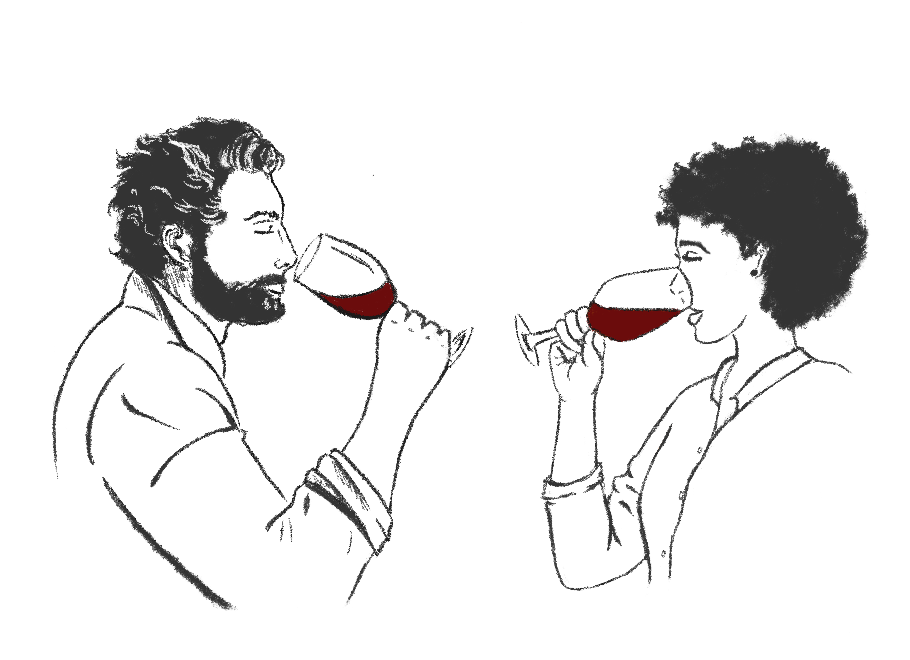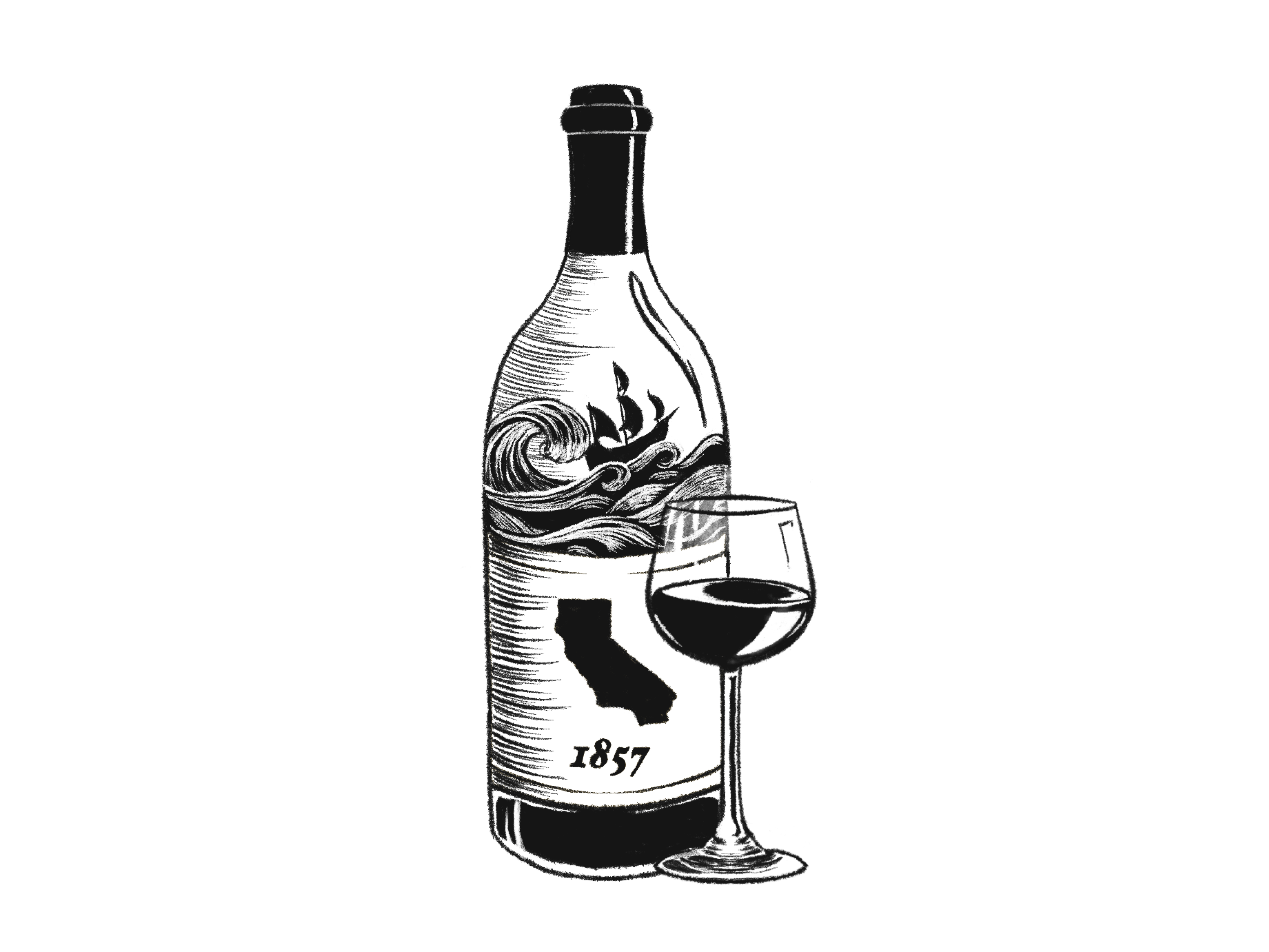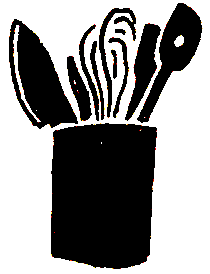
“I use wine as a vehicle to look at what California is.”
12.09.19
I must confess that I was nervous to meet Esther Mobley. Here I was a vinicultural cretin—who orders Pinot Grigio unironically and can barely pronounce Bordeaux—about to interview the woman heralded by the Association of Food Journalists as the wine writer of the year. I arrived early at the bar where we were meeting and ordered a vintage that sounded impressively obscure. But, to my horror, a few moments later, a glass of flamboyantly pink chilled wine hit the table. Not a good start. Mobley arrived a little late, after turning in a last-minute report on the latest in the California wildfires. Gliding through the door, she grabbed a seat and asked about my glass without an ounce of judgment. Within moments, we launched into a conversation about what waiters mean when they call a wine “funky.” Against the odds, my apprehension melted into ease. This ease is also characteristic of Mobley’s writing. In the rarefied field of wine criticism, Mobley strikes a refreshingly democratic tone. Studying English at Smith College, she started her career at Wine Spectator before joining the San Francisco Chronicle as their wine critic in 2015. In this position, Mobley has become the most influential voice chronicling California wine at a moment of immense change in the industry. Yet her subject is less viticulture than human culture. Mobley’s stories traverse a wide range of libation-related topics: agriculture, climate change, immigration, NBA players, corporate branding, and even the chardonnay emoji. “I use wine as a vehicle to look at what California is,” Mobley explains. “Wine touches on every aspect of life in the state: its economy, environment, and politics. It tells the whole history of California.” In this way, Mobley charts a new trajectory for wine criticism that speaks to connoisseur and citizen alike. We talked over chilled red wine about the strange popularity of the adjective “funky,” separating the science and the myth behind tasting descriptions, and the challenge of writing about wine for a general audience.
1. WHAT DOES FUNKY MEAN TO YOU?
Ted Gioia: I'm not very educated about wine, but I feel like “funky” is one of those uniquely meaningless descriptors. When people don't quite know how to describe a vintage it becomes “funky.”
Esther Mobley: The word is used irresponsibly. There’s no good agreed-upon meaning. I know what I mean when I use it, but it’s still kind of vague. This is the problem with a lot of wine terminology. Everyone is using the same words to get at slightly different things.
TG: So what does “funky” mean to you? [Chuckles]
EM: “Funky” is an umbrella term. I use “clean” and “funky” as opposites. Now that people are interested in natural wine and flavors that aren’t perfectly clean, I think “funky” kind of encompasses that earthiness.
TG: What do you think of the language of wine at a larger scale? I'm not sure where all the standard terms originate from. It seems like half science and half marketing jargon.
EM: It's certainly partially science. Some terms can be correctly identified by their molecules. When we talk about wine tasting like green pepper (which is a common descriptor) that’s actually because they have a compound called Pyrazine that’s found in the pepper.
TG: So when they say hints of cherry?
EM: I couldn't tell you specifically about cherry, but some of the words have real chemical analogues. But that's probably giving wine people more credit than they deserve because a lot of the language is a wild word association game.
At this point, I’ve tasted enough that I know certain things to be true and not to be bullshit. Chardonnay and “buttery” is another good example. When Chardonnay undergoes malolactic fermentation, it produces a byproduct of a compound called Diacetyl which makes it taste and smell super buttery. And, in fact, that's the same compound they use for butter in movie popcorn.
But I hope I've maintained some kind of skepticism about the tasting vocabulary even though I’m part of the wine-writing apparatus. When people talking about a Cabernet Sauvignon with Pyrazines start distinguishing between jalapeno pepper and green bell pepper, spearmint and peppermint—sometimes I don't know how we’re supposed to taste that level of detail.
TG: Those feel like projection to me. It’s all part of the idea that by paying attention to something—by specifically looking for the peppermint in the Merlot—perhaps you’re able to teach yourself to perceive it. More so than food, I think the way we talk and write about wine influences how we taste it. God knows I’ve been to wine rooms where I pretend to taste what they’re describing. “Oh, this is what cardamom and black currant tastes like!”
EM: Right, I think of wine descriptors as a kind of doublespeak. You say this wine tastes like red cherry. Well, it doesn’t literally taste like the sensation of biting into a cherry. But I remember the first time someone told me wine tasted like cherries when I was 21 and working in a wine shop. After that, I knew what smell they were referring to and started to notice it in other wines. Then I could say, “This is like the wine version of red cherry.” It's a little manipulative because you’re using familiar terms but with meanings that not everyone can immediately grasp.
TG: Do you try to introduce different types of words or vocabularies into wine writing?
EM: Yes, although I'm guilty of falling into all the annoying traps.
TG: —Oh, we’re all guilty of that!
EM: I try to describe wine with more than a laundry list of obscure-sounding roots. For me, as a drinker, it’s more helpful to know: “Is it a big wine or a small wine?” “Is it a loud wine or a quiet wine?” There are broader ways in which we can talk about the structure and tension of the wine, but I think evoking the mood of the wine is often more helpful than saying it tastes like ingredient X. I wouldn’t choose a wine because “it smells like lavender” or “tastes like black cherry.”
TG: I’ve noticed there's a big difference between the language of wine compared to beer, spirits, or other kinds of alcohol. It feels a little gendered at times.
EM: What do you mean by that?
TG: Well, I think that the language of beer is self-consciously male. All these IPAs have such incredibly aggressive names. There's something about displaced male identity in names like Arrogant Bastard or Suicide Squeeze which feel like some sort of challenge to one’s manliness. Have you noticed other differences between the languages?
EM: Well, in defense of wine people, I think wine is capable of expressing more nuanced flavors than beer or spirits. So, I think there’s actually more to say about wine. The gender question is interesting. In the lecture circuit, people often use the terms “masculine” or “feminine” to describe wines. “This is a more masculine Pinot Noir. This is a more feminine Pinot.” I’ve used those terms in the past, but wouldn’t use them now.

TG: What is a masculine or feminine wine?
EM: Well, the explanation I’m going to use may seem a little obnoxious. But a masculine wine is a more muscular wine, more structured. It might have more tannin, more weight, more body. A feminine wine would probably be lighter, softer in terms of not having as much tannin or structure. It might have quieter, subtle flavors. We might talk about masculine wines as smelling like meat or bacon, and feminine wines as smelling like flowers. Now, I observe those kind of contrasts in wine all the time, but I’m no longer comfortable using gendered language to express that contrast.
TG: Do you feel like being a female writer in a largely male-dominated field influences your perspective in any way?
EM: Interesting. I don’t know. I think it probably influences the way I approach stories and interview people. But I don’t really know.
TG: How do you interview people?
EM: Again, I don't want to say that male wine writers interview people in a fundamentally different way. But being a younger woman, I suspect that people can be a little more comfortable around me. When I interview, I’m trying to connect with people and not to impose an intimidating presence. That may have nothing to do with my gender. Maybe unfairly, especially when I first started my role, I assumed people were under-estimating me. I always hoped to use that to my advantage.
TG: I don't mean to be prescriptive or suggest there’s some universal rule. I’m interested if there are times when your gender informs the way you react to something that makes your prose more personal and perhaps more real. I was thinking of your hilarious satirical article on the Bud Light Lime-A-Rita.
EM: Yeah, I can write stuff like that. I enjoy occasionally calling out sexism where I see it in articles like the Lima-A-Rita piece. It’s funny. When I started at the Chronicle four years ago, there were very few other women writing about wine who had a real platform. That's really changed in the last 4 or 5 years. When I look around, a lot of the writers doing the best work in my field are women in their 20s and 30s.
2. LESSONS FROM THE NEGATIVE REVIEW
TG: What are your thoughts on the negative review?
EM: For my first 3 years at the Chronicle I had a column reviewing bars. Absolutely, my highest traffic numbers came from total slammers—and, for the most part, I think my best writing appeared in the negative reviews.
TG: This is a dilemma I'm trying to unpack. As a critic, when you're being negative, I think you're pushed to be hyper specific and hyper entertaining. There's a mix of reasons why. For one thing, you want to get the reader on your side. In another sense, you're also trying to show off your skills as a writer with show-stopping prose—the fireworks of phrases like “the pasta with truffle oil tasted like a Chihuahua’s bathwater.” But you could do that type of writing in a positive review. It’s harder. But you could write a fun hyperbolic analogy to describe a flavor you enjoyed—something along the lines of “this wine tastes like the opening scene of Pulp Fiction” or whatever. I think it comes down to how specific you’re going to be, and the analogies and metaphors you create.
EM: That's an excellent point: negative reviews are more specific. I wonder if part of the problem is when you’re being positive as a critic you’re still trying to be a little restrained. If I’m writing a glowing review of something, I don’t want to lavish endless praise on it.
For instance, last year I wrote a review of a wine bar and handed in what I thought was a pretty balanced column. I liked the place—that was my honest feeling. But my editor was like, “Could you push a little harder on this. It’s expensive. Do you really think it’s worth that price.” I was recently listening to a podcast interview with Jia Tolentino, and she said, “Every book review needs to have the “but” moment. But where the book falls short . . .”
TG: [Laughs] I know it well.
EM: And I have totally done that in reviews. Like I need to prove to you that I’m capable of being critical. Maybe that's why our positive reviews feel a little less positive and negative reviews feel more negative. It’s not cool as a critic to appear like you’re just a hype machine.
TG: True. John Birdsall has a quote along the lines of “food writing is half journalism and half PR.” Because so much of food writing’s vocabulary borrows from marketing, I think there’s an additional layer of anxiety about effusing too uncritically over the things you love.
3. CALIFORNIA HISTORY TOLD THROUGH WINE
TG: Reading your articles, I was surprised by the sheer variety. It’s not what I expected from wine journalism. There are so many topics: politics, science, religion, even the NBA. How do you look for characters and topics to write about? Are you working against a stereotype in your mind of traditional wine writing?
EM: Honestly, I think a lot of wine writing is boring. There are a few paradigms for what it means to write about wine. One is embodied by the place I worked before the Chronicle, Wine Spectator magazine, whose main features are wine reviews, tasting notes, and scoring wines. There are a lot of critics who believe that’s what it means to critique wine.
Then there is the British School of wine criticism led by figures such as Jancis Robinson and Hugh Johnson whose major contributions to the field are these huge reference works: The World Atlas of Wine, The Oxford Companion to Wine.
Personally, I was an English major interested in a lot of the same questions as you. Wine was the topic I could get a full-time job writing about, and I have developed a passion for it. But I was interested in the same cultural questions no matter what my immediate beat. The cool thing about working for a regional newspaper is that I get to be a beat reporter and a critic. All the other critics at the Chronicle are turning out traditional reviews of things—a restaurant, a play, an opera. I’m not doing that.
I get to practice a more interesting kind of writing where I’m looking critically at a larger cultural ecosystem. Just like environment reporters are covering the wildfires and education reporters are covering local schools, I use wine as a vehicle to look at what California is. Wine touches on every aspect of life in the state: its economy, environment, and politics. It tells the whole history of California. Vines are these amazing natural artifacts. We have vineyards that are over 150 years old which can explain how different groups immigrated here, what they planted, and why they settled in Northern California. Wine is a living artifact that can survive long periods of time, which makes for a rich and compelling topic.

TG: That’s so fascinating. I hadn’t thought about the history embodied in the roots. More so than any other food, wine has millennia of literature around it. Wine is a central character in stories from the Gospels to the Greek gods. So many cultures have myths involving wine.
EM: I think wine is a poignant vehicle for telling us how we live. Like the “funky” thing—that does not exist in a vacuum. That is another manifestation of everything that’s happening in the culture: the fetishizing of the grimy and the “authentic”. The movement away from things that are obviously opulent—the way people are decorating their homes with the spare, bare aesthetic.
TG: Yeah, millennials are abandoning the traditional symbols of upper-class taste for something that's just as expensive but more informal. The “funky” tic is my favorite kind of trend to unpack—because it’s both incredibly specific yet somehow universal. A small detail that tells a larger story about what’s going on in the culture.
EM: Exactly. I wrote a story in this vein about the 2004 vintage of Cabernet from Napa Valley. There's a template for a type of wine criticism called a “retrospective” or a “vintage report,” where you revisit an older vintage of a wine. You check in on a vintage, taste a bunch, and discuss how they’re holding up. The idea is if you’re a collector who has a bunch of 2004s you might want to know if they’re in a good spot or you should keep holding them. Now, I know zero people who would actually find that kind of article useful. So I went in with a different thesis as I tasted a bunch of 2004 wines. The wines from that moment in time were opulent and rich. High in alcohol. Big Oak. Super fruity. What has been termed in our lexicon, “hedonistic fruit bombs.” My thesis was that this flavor profile perfectly tells you what was happening in 2004. When you look at the restaurants opening in that era, they were blustery and over-produced. Nothing seemed natural. The dining rooms felt like night-clubs. And those sexy, luxurious, obvious wines were a great expression of that moment in time. Today’s wines are comfy, lean, subtle, bare bones—which are a perfect expression of 2019 restaurants and our current culture.

4. THE CHALLENGE OF WRITING FOR A GENERAL AUDIENCE
TG: What are the differences between being a wine writer and a food writer?
EM: The challenge for the wine writer is that everyone eats food and not everyone drinks wine. Actually, a lot of people have a real disdain for wine. But no one has a disdain for food. Also, a certain level of food language is universally intelligible—yet even the most basic wine language is already exclusive. So there's a challenge to get a wider range of people to pay attention. My writer’s fantasy is that I can make more people care about wine.
TG: Do you have a target reader or ideal audience? Are you writing for wine experts or the general public?
EM: I want to write for the average Bay Area citizen, who I believe is more in tune with food and wine than your average American (but is still a lay person). Basically, I want to write for the intelligent amateur. Not for the industry. Not for the expert. Maybe that sounds obvious but there are actually very few wine writers doing that—attempting to reach a general audience. I'm probably not quite reaching that audience as well as I’d like. Because wine can be a little niche, once you start writing about viticulture it’s easy only to surround yourself with people who already care about it.
TG: How does the commitment to write for a general audience change your work? For me, as a critic, that meant I had to let go of some of the “ism” words, had to abandon some academic terminology.
EM: Well, part of that change is just dictated by the fact I write for a newspaper. I used to write for a magazine where the copy editors knew more about wine than practically anyone on Earth—and they would catch the slightest error. Then I remember getting to the Chronicle, and the copyeditor would be like, “We don't know that word. You're gonna have to explain it.” I was like, “Everyone knows that French word!”
When I first started, my Chronicle editor would always respond to my story ideas by asking, “Is that wonky?” Wonky was another term for insider. Over time, I’ve developed better instincts for what makes sense for the audience. My own colleagues in the Food Section are a great test subject. I mean they know about wine—they are professional food writers after all—so if they don’t care about a topic then that’s a good hint I shouldn’t write the story. [Laughs]
